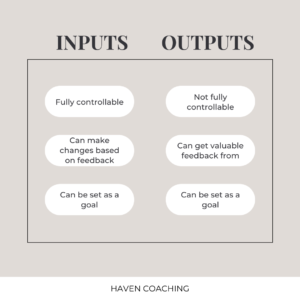Inputs vs. Outputs
During my time as an executive at Amazon, I became known for an email I once sent.
It wasn’t a funny email, and it wasn’t particularly out of the ordinary — to me, at least, when I sent it — but it seemed to have made an impact on my team’s understanding of what they were doing at the time.
Once I started to see the lightbulbs go off around me, and hear my team begin to speak in a different language — the language of that email — I knew I was onto something. I started re-sending the email annually, to new team members, to myself on occasion, and used it no matter what role I was in.
The email subject line was simple:
Inputs vs. Outputs
In the email, I shared a simple thought: that although teams have both INPUT and OUTPUT goals, the INPUTS are the only ones completely in our control.
Said differently, we make changes to INPUTS in order to impact OUTPUTS. Never the other way around.
Because of this, our inputs are the best measure of our progress and performance; not our outputs.

Why is this important?
At the time, I was managing a team of watch buyers. They had a number of lofty goals:
- Which watches to bring on Amazon’s site
- How to price those watches
- What initial inventory levels to have for those watches
- Whether to discount the watches for holidays
- Negotiating costs with vendors
- Revenue
- Profits
I asked the team two simple questions prior to sending that now-infamous email:
Which of your goals are input goals?
Which are output goals?
These were hard questions until we defined what an input is: something that is completely in our control — and what an output is: something that is partially or fully out of our control.
The team quickly realized that revenue and profit are the OUTPUTS, while all their other goals (e.g. pricing, costs, etc.) are the INPUTS.
Revenue is impacted by pricing, for example, which is in a buyer’s control, but it can also impacted by time of year, weather patterns, changing fashion, etc. — all out of the buyer’s control.
This was important for my team to know for two reasons:
1. It’s critical to reach output goals the RIGHT WAY — i.e. by focusing on the inputs, not by “any means possible.”
2. While we set both types of goals, employee performance should be measured against the inputs.
Reaching goals the right way
When you’re able to distinguish inputs from outputs, you’re can clearly understand the feedback loop that happens each time you make a tweak to an input. You can also clearly understand when outputs are impacted by things out of your control.
This allows you and your team to take appropriate actions — ones that are RIGHT for your company, your team, your customers, your shareholders, etc. — rather than ones that just get short-term results.
I’ll share a hypothetical example from the weight loss world.
If you’re looking to lose weight, your goal weight is your output — it’s partially in your control but not fully (it’s also impacted by hormones, genetics, etc.)
Your inputs include things like how much you exercise, the foods you eat, how much water you drink, etc.
If you’re meeting all of your input goals but your weight is increasing instead of decreasing, you might continue doing what you’re doing for a few more weeks, see a doctor, consult a nutritionist or health coach, etc. What you wouldn’t do is stop drinking water the two days before your weigh-in just to meet your weight loss (output) goal!
The same applies at work, though it can perhaps be less obvious at times. Labeling your goals as input and output goals can help.
Employee performance measurement
The other reason it’s critical to distinguish output from input goals is because it helps form the team culture and incentives you want.
As a leader, you want others to know what you most care about.
While you’re setting both output and input goals for the team, and expect both to be met, individual performance should focus on inputs. That means asking employees, what did YOU do to try to achieve your goals? What did you go after? What initiatives did you create?
If at the end of the year, an employee missed every one of their output goals due to circumstances out of their control, but showed their inputs to be outstanding, then they themselves are outstanding as an employee.
—
As an employee or a leader, have you come across this before? Have you struggled with an OUTPUTS-based culture, when you prefer an INPUTS-based one? Or the other way around?
Does this otherwise resonate with you? Share your thoughts in comments below!
Need more 1:1 support? Schedule a FREE consultation with Haven Coaching so we can help you maximize your potential and love what you do.
